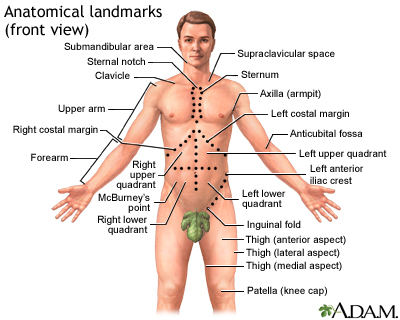Medial
Medial means toward the middle or center. It is the opposite of lateral. The term is used to describe general positions of body parts. For example, the chest is medial to the arm.
Lateral
Lateral means to the side of, or away from, the middle of the body. Examples:The ears are lateral to the nose. The arms are lateral to the chest....

Your health care provider may use this term to clearly explain the relationship between things found during a physical exam or on medical tests.
Reviewed By
Linda J. Vorvick, MD, Clinical Professor, Department of Family Medicine, UW Medicine, School of Medicine, University of Washington, Seattle, WA. Also reviewed by David C. Dugdale, MD, Medical Director, Brenda Conaway, Editorial Director, and the A.D.A.M. Editorial team.
Drake RL, Vogl AW, Mitchell AWM. The body. In: Drake RL, Vogl AW, Mitchell AWM, eds. Gray's Atlas of Anatomy. 3rd ed. Philadelphia, PA: Elsevier; 2021:chap 1.
Merriam-Webster's Medical Dictionary. Medial. www.merriam-webster.com/medical. Accessed July 18, 2022.
Disclaimer




 All rights reserved.
All rights reserved.